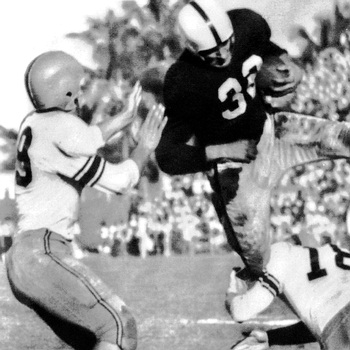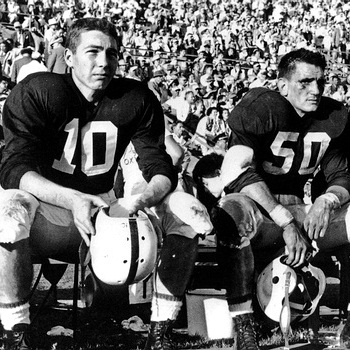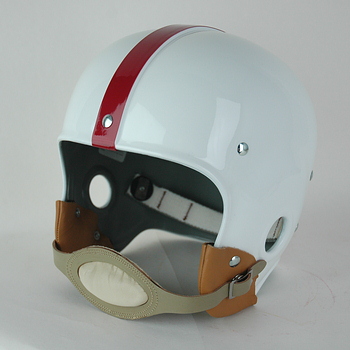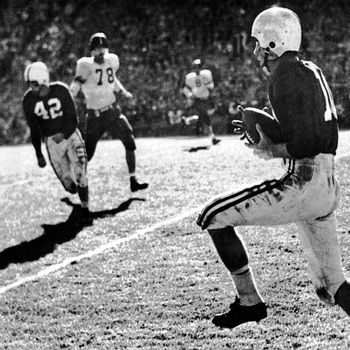

Alabama
1949-1956 Crimson Tide
(Authentic Reproduction)
 |
 |
 |
 |
 |
 |
Serious college football fans know who the heavyweights are although in
terms of absolute number of victories, some of the Ivy League teams
maintain a surprisingly high ranking due to the nature of the game in
its nascent days. However, spanning the various eras of the nation’s
favorite collegiate sport and utilizing different formulas that include
more than the number of victories, all realize that in no specific order
here, the “big boys” include Michigan, Notre Dame, Texas, Nebraska, Ohio
State, Alabama, and Oklahoma. Perhaps the public perception of Alabama
and its socioeconomic history have driven its fans to levels of support
and enthusiasm that are arguably a definitive part of the state’s
culture. Entering the 2016 season, the Crimson Tide has appeared in a
record number sixty-two bowl games, won twenty-nine conference
championships, has completed ten undefeated seasons, and maintains a
winning record over all of its Southeastern Conference opponents. With a
Twenty-First Century revival of top five and National Championship
teams, long-time fans can now trace a lineage of victorious squads and
coaches to the 1920s. The early versions of Alabama football teams were
most often winners, dating to the inauguration of the sport on campus in
1892, but a number of star coaches have guided the fortunes of the
Crimson Tide’s history beginning with Wallace Wade. Under the watch of
Wade, Alabama became the first southern team to play in the Rose Bowl. A
former guard at Brown University, Wade became Alabama’s head coach in
1923 after three years of high school coaching and two as a Vanderbilt
assistant where he also led the basketball squad. His successful 1923
through 1930 reign at Bama that brought a 61-13-1 mark, led to a sixteen
year College Football Hall Of Fame coaching career at Duke that was
interrupted by his service during World War II. Although his Alabama
career has been somewhat overshadowed by his time at Duke, he drove what
had been christened the Crimson Tide in 1907 to an undefeated season in
1925. The fourth or fifth choice to face Washington in the Rose Bowl
game, the national press denigrated the team and southern football with
terms like “Tuscaloosers,” and “Swamp Students” until their 20-19 upset
victory behind the play of halfback and future actor Johnny Mack Brown.
The imposing physical size of his last Bama team in 1930 led to the
often used Red Elephant nickname and introduction of Big Al, the
school’s elephant mascot. Frank Thomas, called the “smartest player I
ever coached” by Notre Dame’s Knute Rockne, took Wade’s post in 1931 and
very much continued Alabama’s successful run, achieving an enviable
115-24-7 record between 1931 and ’46. He won two Rose Bowls, a Cotton
Bowl, and an Orange Bowl and became known for developing the talents of
future collegiate and pro great Don Hutson and “the other end” Paul
Bryant. In his fifteen seasons, he garnered two National and four
Southeastern Conference Championships. He developed collegiate greats
Millard “Dixie” Howell, the provider of the record-setting passes to
Hutson, halfback Harry Gilmer, and center Vaughn Mancha. Most
importantly, his Alabama teams established an identity that the entire
state rallied around, one of toughness and perseverance. Typical was his
1937 Rose Bowl bound team, with the head coach stating that “I tell you
one thing: the Rose Bowl customers are going to see the fightingest
Alabama team that ever came out here. It may not be the most powerful or
most versatile, but this bunch can really get down on the ground and
fight it out with you.” Thomas reluctantly retired to the full time
athletic director’s position prior to the ’47 season due to heart
related problems, stepped down as AD in 1952 and tragically passed away
on May 10, 1954 at the age of fifty-five from a heart attack and blood
pressure related issues. Both his statue and that of Wallace Wade were
erected outside of Bama’s stadium as a testament to their influence.
The torch was passed to Harold "Red" Drew, Thomas’ hand-picked former assistant who had been head coach at Ole Miss. A native of Maine, Drew had played at Bates College before making coaching stops at Trinity (Connecticut), Birmingham Southern, and Chattanooga prior to landing at Alabama and then Mississippi. Drew’s first squad, loaded with many World War II veterans recruited by Thomas, made it to the post-1947 season Sugar Bowl, losing to Texas 27-7. Still wearing black leather helmets, the 1948 team resumed the heated and what had been an interrupted rivalry with Auburn by pounding the Plainsmen 55-0. Introducing the Riddell plastic RT helmet to the squad for the 1949 season, the Tide hit the field wearing a white shell with a one-inch cardinal center stripe and posted a solid 6-3-1 record using the Notre Dame Single Wing that featured the rushing of tailback Ed “Anvil Foot” Salem, the talents of the SEC’s best blocker in back Clarence “Butch” Avinger, and the line talent of Herb Hannah and All SEC pick guard Ed Holdnak. The 9-2 contingent of 1950 was even better with sophomore sensation fullback Bobby Marlow rushing for 882 yards and Salem making All American and playing with the Redskins and Montreal of the CFL. Hannah, teaming with All Conference choices Mike Mizerany at guard and center Pat O’Sullivan were the plow horses on the line, Hannah going pro with the Giants, and his sons John, Charles, and David later becoming Alabama stars. Fullback Avinger again excelled as a blocker and later played in the CFL and with the N.Y. Giants.
A change to a Split-T offense for 1951 saw a drop to 5-6, alarming the faithful as it was the Tide’s first losing season since 1900! Halfback Marlow again was a star, not only on offense with his seventy-two point scoring total and record-setting 233 rushing yards against Auburn, but as an excellent All Conference linebacker. The rebuilding and retooling season featured good performances by frosh fullback Tommy Lewis and guard Jess Richardson. Alabama adapted to the new offense by ’52 as the team posted a 9-2 record, losing only to Tennessee and to Georgia Tech in a close 7-3 defeat. They won an Orange Bowl berth and blew out Syracuse 61-6 while rolling up over 600 yards in total offense in the first of the televised college bowl games. Many performers contributed to the excellent season with guard Jerry Watford, a future Chicago Cardinal, and halfback Cecil “Hootie” Ingram and Marlow named All SEC. Marlow finished his collegiate career rushing for 2560 yards in three seasons. Halfback Thomas “Corky” Tharp added 667 yards on the ground as tackles Sid Youngleman and Ed Culpepper and guard Richardson controlled the line of scrimmage. Richardson became a solid defensive tackle in the pros with the Eagles from ’53 through 1961, and then with the AFL Patriots from 1962 to ’64, also earning recognition for being one of the last men in the NFL to eschew the use of a facemask.
SPOTLIGHT ON BOBBY MARLOW:
Internationally revered author Gay Telese, the founder of the New Journalism style of non-fiction writing, honed his “media res” approach as the Sports Editor of the University of Alabama’s Crimson-White Newspaper. In his popular Sports Gay-zing column, he christened Bobby Marlow “Sir Robert Of Troy.” Marlow was born in Athens, Alabama but was placed in the Troy (Alabama) Baptist Children’s Home at a young age after the death of his parents. Described as a 190 pound piece of strength and steel, he excelled at Troy High School and then lettered from 1950-1952 for the Crimson Tide. At times referred to as “The First Italian Stallion” when comparisons are made to Johnny Musso, Marlow is considered to be one of the two or three greatest running backs in Alabama history. He gained 882 yards his inaugural season, averaging 7.5 yards per carry. In ’51 he rushed for 728 yards and twelve touchdowns, amassing a huge 233 yard rushing day against Auburn, a single game rushing record that stood until 1987. He was placed at linebacker in part to “teach him a lesson” after fumbling while crossing the goal line against Tennessee and this resulted in his All SEC selection as a defensive player. He was named All SEC again in ’52 and an All American, completing his collegiate career with a school record of 2560 yards on the ground. His achievements ranked in the top ten for Bama records in career and single game rushing, rushing touchdowns, and yards per carry. 1952’s SEC Player Of The Year was chosen by the N.Y. Giants as the draft’s eighth overall choice but Marlow instead went to Canada and played for the Saskatchewan Roughriders from 1953 through 1960 where he continued to be reliable and outstanding on both sides of the ball as a two-way back. He was always among the top five or six rushers in his division and excelled as a receiver. He was a five-time West All Star, three times at defensive back and twice as a linebacker, given credit as one of the hardest tacklers of his era. Marlow is a member of the CFL All Time All Star team.
The 1953 season brought perhaps Drew's most famous or infamous game. Graduation losses were significant but Drew felt good about his team. They compiled a 6-2-3 record and Bobby Luna's fourth-quarter field goal which won the Auburn game 10-7 allowed them to face off against Rice in the Cotton Bowl on January 1, 1954. Sophomore quarterback Bart Starr had thrown for 879 yards and was a fine punter, while Tommy Lewis, Corky Tharp, Luna, and Hootie Ingram, Alabama's future AD, provided the backfield speed and power. With Rice ahead 7-6 the Owls' All Everything halfback Dickey Moegle sprinted around his right end with a handoff and streaked up field. As he passed the Tide bench, Lewis, who later explained his unspeakable action as "I'm too emotional, I'm just too full of Alabama" leaped off the bench and bare-headed, dove at Moegle's legs, knocking him to the ground. Awarded the touchdown, Moegle finished a tremendous day with 265 yards on only eleven carries, a 28-6 Rice victory, and no ill will towards Lewis but even to this day, the dramatic sequence of events is often shown during the football season. Lewis later played two seasons in the CFL with Ottawa while two-way tackle Billy Shipp spent ’54 with the Giants before moving up to the CFL and a ten year, all star career with both Montreal and Toronto. A decline to a 4-5-2 record and Drew's inability to recruit top talent announced real trouble. The 1954 record included losses to Southern Miss, Mississippi State, Georgia Tech, and Miami, not the teams Tide fans were used to bowing to. Tackle Sid Youngleman was the best of the bunch up front and played with five NFL and AFL teams in his nine year pro career. Line mate Ed Culpepper too had a good if understated pro career as a defensive tackle with stops in three NFL cities and with the AFL Oilers. With backfield performers Tharp who played in the CFL for four seasons and then with the Rams and AFL Titans, Luna who was with the Forty Niners and Steelers, Ingram, and quarterback Starr, more had been expected. Dropping the annual rivalry game 28-0 to hated Auburn led to Drew's "reassignment" as a full time professor of physical education and the hiring of former Bama player J.B. "Ears" Whitworth as head coach for the 1955 season.
If interested in any of these Alabama helmets please click on the photos below.